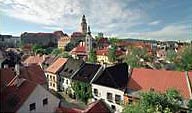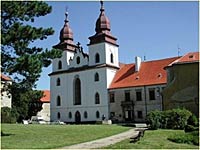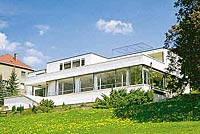YOUR ITINERARY:
PragueDay 1
- On your arrival at Prague airport, meeting with your individual guide and transfer to your hotel.
- Excursion "Prague - 12 centuries of architecture"
 We
will walk from Prague Castle through Mala Strana, across the Charles
Bridge to Old Town Square and finish up at Wenceslas Square. Before
us will unfold the entire history of this ages-old city, from its foundation
in the 9th century up to the events of the 1989 Velvet Revolution. Centuries
come and go as Romanesque rotundas and Gothic towers give way to Renaissance
facades, austere neoclassical palaces and opulent Baroque churches.
The splendid dynamics of Art Nouveau rub shoulders with stunning Cubist
structures. This is the glory of Prague – where the finest examples
of architectural history create a magnificent mosaic.
We
will walk from Prague Castle through Mala Strana, across the Charles
Bridge to Old Town Square and finish up at Wenceslas Square. Before
us will unfold the entire history of this ages-old city, from its foundation
in the 9th century up to the events of the 1989 Velvet Revolution. Centuries
come and go as Romanesque rotundas and Gothic towers give way to Renaissance
facades, austere neoclassical palaces and opulent Baroque churches.
The splendid dynamics of Art Nouveau rub shoulders with stunning Cubist
structures. This is the glory of Prague – where the finest examples
of architectural history create a magnificent mosaic.- Lunch in a traditional Czech restaurant in the city
- Dinner at the hotel.
Prague — Kutna HoraDay 2
- Breakfast at your hotel. Transfer to Kutna Hora.
- Excursion "Kutna Hora"
 During
the Middle Ages, the Kutna Hora silver mines brought fame to the lands
of the Czech Crown, and turned the little town into the richest and
most powerful in the Czech lands. Saint Barbara’s Cathedral (1388),
devoted to the patroness of miners, is one of Europe’s most important
monuments of Gothic architecture. Other jewels include the ancient mint
– The Vlašský Dvur (Italian Court) from the 13th century,
and several patrician houses. The Hrádek (Little Castle), which
is part of the former municipal fortifications, houses the Mining Museum;
the tour includes a visit to a medieval mine. The cloister church in
Sedlec, a short distance from Kutna Hora, houses a sensational Ossuary.
The Ossuary’s interior furniture, including a stupendous chandelier,
is composed exclusively of human skulls and bones, dating mostly from
the Thirty Years' War.
During
the Middle Ages, the Kutna Hora silver mines brought fame to the lands
of the Czech Crown, and turned the little town into the richest and
most powerful in the Czech lands. Saint Barbara’s Cathedral (1388),
devoted to the patroness of miners, is one of Europe’s most important
monuments of Gothic architecture. Other jewels include the ancient mint
– The Vlašský Dvur (Italian Court) from the 13th century,
and several patrician houses. The Hrádek (Little Castle), which
is part of the former municipal fortifications, houses the Mining Museum;
the tour includes a visit to a medieval mine. The cloister church in
Sedlec, a short distance from Kutna Hora, houses a sensational Ossuary.
The Ossuary’s interior furniture, including a stupendous chandelier,
is composed exclusively of human skulls and bones, dating mostly from
the Thirty Years' War.- Lunch in one of the local restaurants
- Return to Prague.
- Dinner at the hotel.
Ceský Krumlov — HolašoviceDay 3
- Breakfast at the hotel. Transfer to Ceský Krumlov. Accommodation in the hotel in Ceský Krumlov.
- Excursion "Ceský Krumlov"
 This
picturesque valley town lies in a looping bend of the Vltava River in
South Bohemia. Cesky Krumlov was founded in the 13th century and contains
superb examples of Gothic, Renaissance and Baroque architecture. It
is an outstanding example of a provincial central European medieval
town. An UNESCO World Heritage site, its architectural heritage has
remained intact thanks to its peaceful evolution over the centuries.
According to legend, the name Krumlov derives from the German “Krumme
Aue”, or “crooked meadow”, and describes the serpentine
meandering of the Vltava River through the heart of the town. The large,
refurbished 18th century Rococo Theater boasts a priceless collection
of original scenery, costumes, furnishings and functioning machinery
that has no equal in the world.
This
picturesque valley town lies in a looping bend of the Vltava River in
South Bohemia. Cesky Krumlov was founded in the 13th century and contains
superb examples of Gothic, Renaissance and Baroque architecture. It
is an outstanding example of a provincial central European medieval
town. An UNESCO World Heritage site, its architectural heritage has
remained intact thanks to its peaceful evolution over the centuries.
According to legend, the name Krumlov derives from the German “Krumme
Aue”, or “crooked meadow”, and describes the serpentine
meandering of the Vltava River through the heart of the town. The large,
refurbished 18th century Rococo Theater boasts a priceless collection
of original scenery, costumes, furnishings and functioning machinery
that has no equal in the world.- Lunch in one of local restaurants.
- Excursion "Holašovice"
 Holašovice
is an exceptionally well-preserved example of traditional central European
village life. It has a large number of outstanding 18th and 19th century
buildings showing off the style known as South Bohemian Folk Baroque,
and retains a ground plan dating from the Middle Ages. Its twenty-odd
farmhouses with richly-painted Baroque gables and rear gardens are situated
around a central pond. The pond was used for breeding freshwater fish;
the entire area is still known for its fish industry. The village is
a living monument to rustic traditions, in the spirit of “The
Bartered Bride”, perhaps the most famous Czech opera (in fact,
the village served as a set for the opera’s film version.). A
working village, Holasovice attracts thousands of visitors from all
over the world who wish to experience how life was lived two hundred
years ago.
Holašovice
is an exceptionally well-preserved example of traditional central European
village life. It has a large number of outstanding 18th and 19th century
buildings showing off the style known as South Bohemian Folk Baroque,
and retains a ground plan dating from the Middle Ages. Its twenty-odd
farmhouses with richly-painted Baroque gables and rear gardens are situated
around a central pond. The pond was used for breeding freshwater fish;
the entire area is still known for its fish industry. The village is
a living monument to rustic traditions, in the spirit of “The
Bartered Bride”, perhaps the most famous Czech opera (in fact,
the village served as a set for the opera’s film version.). A
working village, Holasovice attracts thousands of visitors from all
over the world who wish to experience how life was lived two hundred
years ago.- Return to the hotel in Ceský Krumlov.
- Dinner at the hotel.
Telc — TrebicDay 4
- Breakfast at the hotel. Transfer to Telc.
- Excursion "Telc"
 The
gorgeous Moravian town of Telc is a legendary place, not for any historical
battles fought here – rather it is that each bell tower and chapel
has its own decidedly Gothic tale to tell. This is the locale of the
mysterious White Lady of the Czech Lands. In her fluttering gown, she
flits along the cobbled streets and past the tiny square’s colorful
16th century Renaissance facades. Who is she? A noblewoman who survived
the awesome fire of 1530 which destroyed the original town? No one knows,
but her sightings have given local citizens and many Czech writers a
wealth of stories of unrequited love and rebellious phantoms…
The
gorgeous Moravian town of Telc is a legendary place, not for any historical
battles fought here – rather it is that each bell tower and chapel
has its own decidedly Gothic tale to tell. This is the locale of the
mysterious White Lady of the Czech Lands. In her fluttering gown, she
flits along the cobbled streets and past the tiny square’s colorful
16th century Renaissance facades. Who is she? A noblewoman who survived
the awesome fire of 1530 which destroyed the original town? No one knows,
but her sightings have given local citizens and many Czech writers a
wealth of stories of unrequited love and rebellious phantoms…- Lunch in one of local restaurants.
- Excursion "The Jewish Quarter of Trebic"
-
 Our
destination is a unique monument to Jewish history, included on UNESCO’s
list of World Heritage sites. The Jewish Quarter of Trebic is an exceptional
testament to the cultural traditions of the Jewish Diaspora in central
Europe. Its walls and ancient houses bear witness to the longevity
and vibrancy of the life of this community. The proximity of the Jewish
Quarter, the old Jewish Cemetery and the Basilica of Saint Procopius
reminds of the co-existence of Jewish and Christian cultures in Trebic
from the Middle Ages to the 20th century. The Basilica, built as part
of the Benedictine monastery in the early 13th century, is a remarkable
example of the influence of Western European architectural heritage
in this region.
Our
destination is a unique monument to Jewish history, included on UNESCO’s
list of World Heritage sites. The Jewish Quarter of Trebic is an exceptional
testament to the cultural traditions of the Jewish Diaspora in central
Europe. Its walls and ancient houses bear witness to the longevity
and vibrancy of the life of this community. The proximity of the Jewish
Quarter, the old Jewish Cemetery and the Basilica of Saint Procopius
reminds of the co-existence of Jewish and Christian cultures in Trebic
from the Middle Ages to the 20th century. The Basilica, built as part
of the Benedictine monastery in the early 13th century, is a remarkable
example of the influence of Western European architectural heritage
in this region. - Accommodation in the hotel in Trebic.
- Dinner at the hotel.
Ždar nad Sazavou — LitomyšlDay 5
- Breakfast at your hotel. Transfer to Ždar nad Sazavou.
- Excursion "Church of St John Nepomuk at Zelena Hora"
 Mysticism
is closely intertwined here with reality. Eerily decorated with cabalistic
symbols, the Church of Saint John Nepomuk at Zelena Hora has five angles
& five sanctuaries. You can enter any of the church's five doors
to view a giant human tongue suspended under its dome…
Mysticism
is closely intertwined here with reality. Eerily decorated with cabalistic
symbols, the Church of Saint John Nepomuk at Zelena Hora has five angles
& five sanctuaries. You can enter any of the church's five doors
to view a giant human tongue suspended under its dome…
- Lunch in one of local restaurants.
- Transfer to Litomyšl.
- Excursion «Litomyšl»
 The
tiny town of Litomyšl has been the setting for several seminal
events in Czech history. Back in the 9th century, it was the first town
to open its gates to the Apostles of the Slavs, Cyril and Methodius;
the former is credited with inventing Cyrillic script in order to translate
the gospels into the original Slavic tongue. It was here in 1824 that
the greatest Czech composer, Bedrich Smetana, was born. The medieval
chateau in Litomysl has an exceptional example of original Italian sgraffito
and the quaint town square is done up like a wedding cake, with its
embellished Baroque facades.
The
tiny town of Litomyšl has been the setting for several seminal
events in Czech history. Back in the 9th century, it was the first town
to open its gates to the Apostles of the Slavs, Cyril and Methodius;
the former is credited with inventing Cyrillic script in order to translate
the gospels into the original Slavic tongue. It was here in 1824 that
the greatest Czech composer, Bedrich Smetana, was born. The medieval
chateau in Litomysl has an exceptional example of original Italian sgraffito
and the quaint town square is done up like a wedding cake, with its
embellished Baroque facades.
- Accommodation in Litomyšl.
- Dinner at the hotel.
Olomouc — KromerížDay 6
- Breakfast at your hotel. Transfer to Olomouc.
- Excursion "The Holy Trinity Column in Olomouc"
 The
Holy Trinity Plague Column, a huge affair which dominates Olomouc’s
upper square, came into existence between 1716 and 1754, and is a monument
to the age-old religious history of this ancient seat of Moravia’s
archbishopric. The massive column unites the motifs of ecclesiastic
triumphalism and faith with its architectural and artistic expression.
Done in a regional style known as Olomouc Baroque, the Holy Trinity
Column soars 35 meters above the square. The distinguished Moravian
artist, Ondrej Zahner, created its many fine religious sculptures. The
historic Moravian town of Olomouc has received wide recognition since
Holy Trinity Column joined the UNESCO World Heritage site list.
The
Holy Trinity Plague Column, a huge affair which dominates Olomouc’s
upper square, came into existence between 1716 and 1754, and is a monument
to the age-old religious history of this ancient seat of Moravia’s
archbishopric. The massive column unites the motifs of ecclesiastic
triumphalism and faith with its architectural and artistic expression.
Done in a regional style known as Olomouc Baroque, the Holy Trinity
Column soars 35 meters above the square. The distinguished Moravian
artist, Ondrej Zahner, created its many fine religious sculptures. The
historic Moravian town of Olomouc has received wide recognition since
Holy Trinity Column joined the UNESCO World Heritage site list.- Lunch in one of local restaurants
- Excursion «Kromeríž»
 The
city of Kromeríž has often been dubbed Moravia’s answer
to Athens – or, could it be Rome? The aristocratic Liechtenstein
family, who dominated so much of the city’s early history, created
the lavish 17th century Baroque Flower Garden with an odd nod to both
cultures, combining a massive Neoclassical colonnade with a phalanx
of Roman gods. Off the Old Town Square is another Baroque masterpiece,
the Kromeríž Archbishop’s Palace, for centuries the
home of Olomouc’s bishops, now most famous for its art collection
of masterpieces by Antonin Van Dejk, Albrecht Durer and Titian.
The
city of Kromeríž has often been dubbed Moravia’s answer
to Athens – or, could it be Rome? The aristocratic Liechtenstein
family, who dominated so much of the city’s early history, created
the lavish 17th century Baroque Flower Garden with an odd nod to both
cultures, combining a massive Neoclassical colonnade with a phalanx
of Roman gods. Off the Old Town Square is another Baroque masterpiece,
the Kromeríž Archbishop’s Palace, for centuries the
home of Olomouc’s bishops, now most famous for its art collection
of masterpieces by Antonin Van Dejk, Albrecht Durer and Titian.- Dinner and accommodation in Kromeríž.
Brno — LedniceDay 7
- Breakfast at your hotel. Transfer to Brno.
- Excursion «Villa Tugendhat»
 The
genius German architect, Ludwig Mies van der Rohe, never lived in the
houses he designed. Yet, this never stopped Rohe from preaching his
functionalist approach to modern habitation. The Tugendhat Haus in Brno,
designed in 1930 for the wealthy Tugendhat family, owners of several
textile factories, remains an outstanding example of Functionalism for
architects the world over. The villa impresses with its innovative open-plan
living areas, and the technical devices Rohe introduced, revolutionary
for the 1930’s, are unique even today. The villa’s steel
frame, with floor-to-ceiling windows, and the slim chrome-plated pillars
carrying the weight of the individual floors, visually integrate the
hall and garden into a single whole. Rohe’s design was internationally
recognized as a breakthrough in the annals of modern architecture.
The
genius German architect, Ludwig Mies van der Rohe, never lived in the
houses he designed. Yet, this never stopped Rohe from preaching his
functionalist approach to modern habitation. The Tugendhat Haus in Brno,
designed in 1930 for the wealthy Tugendhat family, owners of several
textile factories, remains an outstanding example of Functionalism for
architects the world over. The villa impresses with its innovative open-plan
living areas, and the technical devices Rohe introduced, revolutionary
for the 1930’s, are unique even today. The villa’s steel
frame, with floor-to-ceiling windows, and the slim chrome-plated pillars
carrying the weight of the individual floors, visually integrate the
hall and garden into a single whole. Rohe’s design was internationally
recognized as a breakthrough in the annals of modern architecture.- Lunch in one of local restaurants.
- Excursion "Lednice-Valtice Cultural Landscape"
 From
their beginnings in the 13th century until the 20th century, the all-powerful
Liechtenstein aristocracy transformed their domains in southern Moravia
into a striking landscape. Their castles at Lednice and Valtice married
Baroque, Classical and Neo-Gothic styles with a huge swathe of countryside
fashioned according to the principles of English romantic landscape
architecture. Today the former holdings include ornately-appointed chateaux,
the famous vineyards, whimsical garden structures and decorative sculpture
of various styles, surrounded by a beautiful natural park dotted with
Romantic outbuildings, rare trees, fishponds and greenhouses teeming
with tropical plants. At 200 sq. kilometers, it is one of the largest
artificial landscapes in Europe.
From
their beginnings in the 13th century until the 20th century, the all-powerful
Liechtenstein aristocracy transformed their domains in southern Moravia
into a striking landscape. Their castles at Lednice and Valtice married
Baroque, Classical and Neo-Gothic styles with a huge swathe of countryside
fashioned according to the principles of English romantic landscape
architecture. Today the former holdings include ornately-appointed chateaux,
the famous vineyards, whimsical garden structures and decorative sculpture
of various styles, surrounded by a beautiful natural park dotted with
Romantic outbuildings, rare trees, fishponds and greenhouses teeming
with tropical plants. At 200 sq. kilometers, it is one of the largest
artificial landscapes in Europe.- Dinner and accommodation in Lednice.
PragueDay 8
- Breakfast at your hotel. Transfer to Prague. Free time to relax and discover Prague at your own pace.
- Transfer to the airport with your guide, departure.